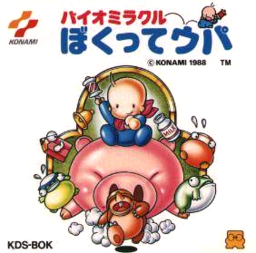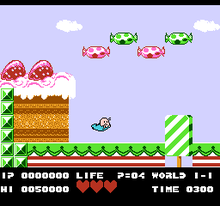- Bio Miracle Bokutte Upa
-
Bio Miracle Bokutte Upa 
Front cover of the Family Computer Disk System versionDeveloper(s) Konami Publisher(s) Konami Platform(s) Family Computer Disk System, Family Computer, Mobile Phones, Virtual Console
Release date(s) FDS
Famicom
i-mode
Virtual Console (NES version)
Genre(s) Platformer Mode(s) Single-player Media/distribution FDS disk, cartridge Bio Miracle Bokutte Upa (バイオミラクル ぼくってウパ Baio Mirakuru Bokutte Upa, lit. "Bio Miracle—I'm Upa") is a Konami video game that was first released for a Japan-exclusive market in 1988 for the Family Computer Disk System. It was later released as a cartridge in 1993 for the Family Computer.
Although Bio Miracle Bokutte Upa had actually been slated for a North American release in 1989, Howard Lincoln of Nintendo turned it down, saying that it wasn't good enough for the American market.[citation needed] On June 9, 2008 it was finally released in North America for Wii's Virtual Console service.[1]
Contents
Story
"Upa is the prince of a magical kingdom and the most recent in a line of brave fighters. One day, though, he broke an urn containing the spirit of Zai, an incredibly evil goatish demon who takes the life force of the kingdom's adults and kidnaps all the babies - except for Upa, who is given a magical rattle by a fairy who was trapped in the urn along with Zai. And so, in order to save his kingdom, Upa crawls into action..."[2]
Game description
Bio Miracle Bokutte Upa's main character is a baby called Upa that uses a rattle to attack his enemies. When injured by the rattle, the enemy inflates and floats away. These inflated enemies can then be used as temporary floating platforms to climb to higher places or they can also be used as weapons if pushed in any direction. If used as a platform, Upa must not stay on top for too long or otherwise it will explode. But if used as a weapon, Upa has to pounce or use his rattle on the inflated enemy to cause it to careen. The enemy will then ricochet off objects and potentially cause damage to both the protagonist and other enemies if it comes in contact with them.
The game uses a health meter to monitor the player's remaining life which can be replenished by obtaining bottles of milk scattered throughout the levels. A heart icon can also be obtained, increasing the maximum health by one unit for the duration of the current world.
Most items, including the milk bottles and hearts, can be collected by striking special blocks which feature Upa's face. Other items include: Apples, which increase the player's score; hourglasses, which temporarily freeze enemies in place; bells, which give Upa temporary invincibility and the ability to run; and scorpion blocks, which kills all enemies on screen when it is pushed off a platform and hits the ground.
Release history
Cartridge version
In 1993, it was released as a cartridge for the Family Computer. While it is practically identical to the Family Computer Disk System version of the game, there are a few differences. The most notable difference is in the game's sound. The Family Computer Disk System contained an extra audio channel not available in the Family Computer/NES games. To compensate for the missing audio channel, the music in the Family Computer cartridge version had to be remixed. Also, added to the Family Computer version was a difficulty option. Now, the player is given a choice between an "Easy" mode (where enemy damage is reduced and the player starts with more lives) and a "Normal" mode, which is the same difficulty as the original FDS version. Finally, among the smallest of alterations to the game is the title screen, which no longer contains a large image of Upa when it is first displayed.
Mobile Phones Version
In 2006, Bio Miracle Bokutte Upa was released for mobile phones.
Virtual Console
On June 3rd, 2008, the Family Computer Disk System version of Bio Miracle Bokutte Upa was made available in Japan for Wii's Virtual Console download service. The same version was also released in North America on June 9th, 2008 and in Europe on August 29th, 2008, as an import, sold at a price of 600 Wii Points.
Other Appearances
Upa has many guest appearances to other Konami games. In these works the sister, "Le" may also appear together.
- Wai Wai World 2 SOS!! Parsley Castle (NES)
Upa forms have appeared in character as one of the main character Rikkuru transformation of the robot. Performance is close to this work.
- Parodius series
- Best Parodius (SNES version only)
Shooter. Upa a limited edition Super Nintendo, Le and her sister (2P character) appears as a ship. In addition, other common models such as the arcade version, which provides a stage inside the cake candy burrowing.
-
- Live chat Parodius (SNES, Playstation, Sega Saturn)
Following the previous appearance. With the contents of the "Raiden" "Oh master," has become aware that such things. PlayStation Portable "Parodius Portable," which also appeared in the same work.
- pop'n music series (Arcade, PlayStation 2)
Game Music "BEMANI series" One. "Pop'n music 9" by, arranged by T. Uchida and the BGM of this work can Mr.T "What I Upa? (Genre: Bio Miracle)" has been recorded. Guest appearances and songs as well as a character in charge of Upa, Upa and Le as the player character (2P color) can be used. In the arcade version of "9" is still in the works since the acquisition. In addition, Le is "ee'MALL 2nd avenue" was delivered in "Twinbee" music arrangement of "Twin Bee ~ Generation X ~" There is a character that had been in charge of the PlayStation 2 "pop'n music 13 Carnival "was also included," - 17 THE MOVIE "later appeared in the character himself responsible for Twinbee anymore.
- Konami Wai Wai World (for a mobile phone apps)
At i-appli version was ported for 2006, from copyright issues, "The Goonies' Mikey's behalf as a character, has appeared with the cake-conscious stage of this work. Version also appeared S! Applications and BREW versions later.
- Baseball Spirits Series Pro Series Powerful Pro Baseball
The main theme has been included in the creation mode to fight songs of the sample songs and cheering Purosupi Power Pro.
References
External links
Categories:- 1988 video games
- Famicom Disk System games
- Konami games
- Nintendo Entertainment System games
- Mobile phone games
- Virtual Console games
Wikimedia Foundation. 2010.

